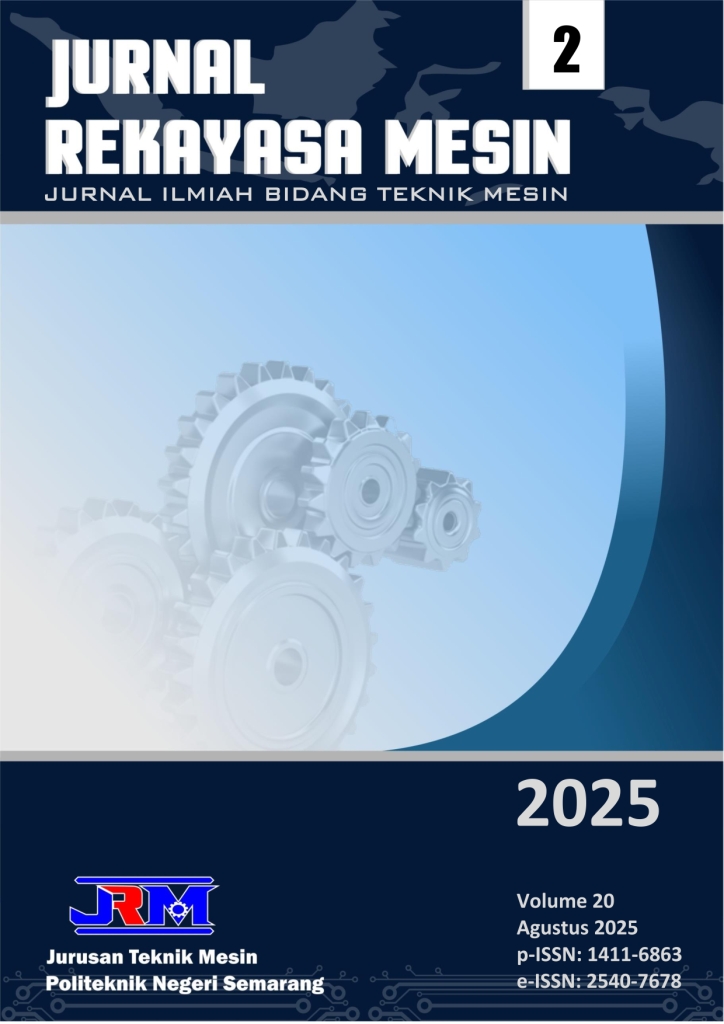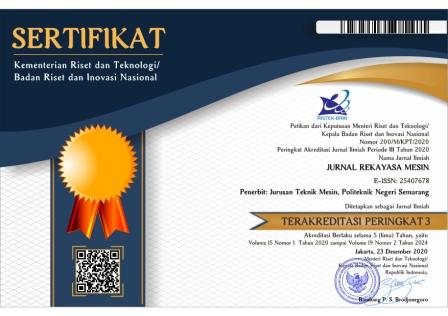Corrosion and Wear Rate Analysis of SS304 Stainless Steel with Composite Coating Variations: Aluminum/Silicon Carbide/Epoxy and Titanium Dioxide/Silicon Carbide/Epoxy
DOI:
https://doi.org/10.32497/jrm.v20i2.6634Abstract
The palm oil industry presents significant challenges to material durability due to its corrosive and abrasive environment, particularly affecting components such as screw conveyors made from SS304 stainless steel. This study aims to analyze the influence of composite coating variations based on epoxy resin with the addition of aluminum (Al), silicon carbide (SiC), and titanium dioxide (TiO₂) on the corrosion and wear rates of SS304 in an H₂SO₄ medium. The methods employed include corrosion testing using the weight loss method in accordance with ASTM G31-72, and wear testing using the Ogoshi method following ASTM G99. Four specimen variations were evaluated: uncoated (Raw), pure epoxy, epoxy–Al–SiC (A), and epoxy–TiO₂–SiC (B).The results indicate that Specimen B exhibited the best corrosion resistance, with the lowest corrosion rate of 0.00798 mm/year, while Specimen A demonstrated the highest wear resistance, with a wear rate of 0.00042 mm³/kg·m. The pure epoxy specimen showed the poorest performance in both aspects. These findings confirm that the incorporation of reinforcing particles into the epoxy matrix plays a significant role in enhancing corrosion and wear resistance, thereby contributing to extended service life and improved equipment efficiency in extreme industrial environments.
References
[1] S. M. Hassan, S. F. Forsido, Y. B. Tola, and A. M. Bikila, “Physicochemical, nutritional, and sensory properties of tortillas prepared from nixtamalized quality protein maize enriched with soybean,” Appl. Food Res., vol. 4, no. 1, p. 100383, 2024, doi: 10.1016/j.afres.2023.100383.
[2] A. A. Irgashev and F. A. Ergashev, “Screw conveyor with anti-friction polymer coating for cotton transportation,” J. Phys. Conf. Ser., vol. 2176, no. 1, 2022, doi: 10.1088/1742-6596/2176/1/012060.
[3] A. Rofeg, M. Khabib, and R. Winarso, “Pembuatan Mesin Screw Conveyor Untuk Pencampuran Garam Dan Iodium Sesuai Sni 3556,” J. Crankshaft, vol. 1, no. 1, 2018, doi: 10.24176/crankshaft.v1i1.2583.
[4] E. Sulistyaningsih and N. Lestari, “Coating of Polyaniline-Titanium Dioxide (PAni-TiO2) Composite for Corrosion Protection in Low Carbon Steel,” IOP Conf. Ser. Mater. Sci. Eng., vol. 807, no. 1, 2020, doi: 10.1088/1757-899X/807/1/012046.
[5] E. Calderón Freire, A. Tenicota García, C. Redroban, J. Caiza Vega, and F. Gamboa Rodriguez, “Efficiency of Conventional Method of Protection Against Corrosion in ASTM A36 Steels in Saline Medium,” ESPOCH Congr. Ecuadorian J. S.T.E.A.M., vol. 3, no. 3, pp. 179–192, 2024, doi: 10.18502/espoch.v3i3.16621.
[6] S. Rana, M. Hasan, M. R. K. Sheikh, and A. N. Faruqui, “Effects of aluminum and silicon carbide on morphological and mechanical properties of epoxy hybrid composites,” Polym. Polym. Compos., vol. 30, pp. 1–9, 2022, doi: 10.1177/09673911211068918.
[7] N. Elangovan et al., “Development and electrochemical investigations of enhanced corrosion-resistant Polyvinylcarbazole-TiO2 hybrid nanocomposite coatings on 316L SS for marine applications,” Surf. Coatings Technol., vol. 481, Apr. 2024, doi: 10.1016/j.surfcoat.2024.130628.
[8] G. Malik, P. Tiwari, N. Choudhary, J. Hirpara, A. Kumar, and R. Chandra, “Investigation of wear and corrosion characteristics of PTFE/TiN composite coating on SS-304 fabricated by two-step sputtering technique,” Surf. Coatings Technol., vol. 466, no. June, p. 129660, 2023, doi: 10.1016/j.surfcoat.2023.129660.
[9] A. Royani, “Pengaruh Suhu Terhadap Laju Korosi Baja Karbon Rendah Dalam Media Air Laut,” J. Simetrik, vol. 10, no. 2, pp. 344–349, 2021, doi: 10.31959/js.v10i2.493.
[10] D. Nan et al., “Epoxy primer topcoat syncretic coating prepared by using modified graphene oxide incorporated with TiO2 nanoparticles,” Mater. Today Sustain., vol. 21, Mar. 2023, doi: 10.1016/j.mtsust.2022.100282.
[11] I. Eka Putra and M. F. Wahyudi, “Effect of Adding Primary Epoxy on the Corrosion Rate of Low Carbon Steel in 3.56% NaCl Solution,” J. Tek. Mesin, vol. 12, no. 1, pp. 47–50, Apr. 2022, doi: 10.21063/jtm.2022.v12.i1.47-50.
[12] N. Hammouda, H. Chadli, G. Guillemot, and K. Belmokre, “The Corrosion Protection Behaviour of Zinc Rich Epoxy Paint in 3% NaCl Solution,” Adv. Chem. Eng. Sci., vol. 01, no. 02, pp. 51–60, 2011, doi: 10.4236/aces.2011.12009.
[13] L. Budiyanto, S. Sulistyo, and S. Nugroho, “Perlindungan Korosi Pada Material Baja a36 Melalui Proses Pengecetan Untuk Lambung Kapal,” J. Sains Dan Teknol. Marit., vol. 21, no. 1, p. 1, 2020, doi: 10.33556/jstm.v21i1.264.
[14] A. N. A. R. Banjarnahor, W. Amiruddin, and Samuel, “Jurnal Teknik Perkapalan,” J. Tek. Perkapalan, vol. 10, no. 3, pp. 11–20, 2022, [Online]. Available: https://ejournal3.undip.ac.id/index.php/naval
[15] T. Zhang, T. Zhang, Y. He, S. Zhang, B. Ma, and Z. Gao, “Long-term atmospheric aging and corrosion of epoxy primer-coated aluminum alloy in coastal environments,” Coatings, vol. 11, no. 2, pp. 1–23, Feb. 2021, doi: 10.3390/coatings11020237.
[16] P. Wang, H. Liang, L. Jiang, and L. Qian, “Effect of nanoscale surface roughness on sliding friction and wear in mixed lubrication,” Wear, vol. 530–531, no. March, 2023, doi: 10.1016/j.wear.2023.204995.
[17] S. H. Siregar, P. Prasetya, N. Norramizawati, M. Marlian, and A. R. Ramadhanti, “Titanium Dioxide (TiO2) Modified Bentonite for Photodegradation in Methylene Blue Dye,” J. Kim. Sains dan Apl., vol. 26, no. 4, pp. 143–150, 2023, doi: 10.14710/jksa.26.4.143-150.
[18] X. Liu, Y. Wan, and X. Zhang, “Preparation and Corrosion Properties of TiO2-SiO2-Al2O3 Composite Coating on Q235 Carbon Steel,” Coatings, vol. 13, no. 12, 2023, doi: 10.3390/coatings13121994.
[19] A. Nassar, M. Salem, I. El-Batanony, and E. Nassar, “Improving wear resistance of epoxy/SiC composite using a modified apparatus,” Polym. Polym. Compos., vol. 29, no. 9_suppl, pp. S389–S399, 2021, doi: 10.1177/09673911211002731.
[20] P. U. Sriwijaya, “Buku pendukung perkuliahan pengendalian korosi dan perlakuan permukaan,” pp. 1–103, 2018.
Downloads
Published
How to Cite
Issue
Section
License
Copyright (c) 2025 Niko Ario Septian, Hendrix Noviyanto Firmansyah, Kriswanto, Eni Safriana

This work is licensed under a Creative Commons Attribution-NonCommercial-ShareAlike 4.0 International License.
Copyright of articles that appear in Jurnal Rekayasa Mesin belongs exclusively to Penerbit Jurusan Teknik Mesin Politeknik Negeri Semarang. This copyright covers the rights to reproduce the article, including reprints, electronic reproductions, or any other reproductions of similar nature.







